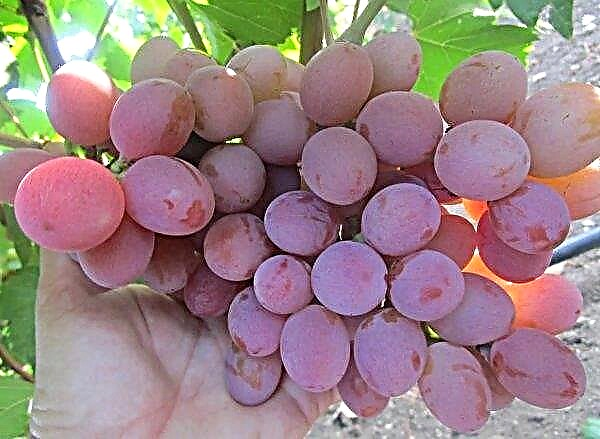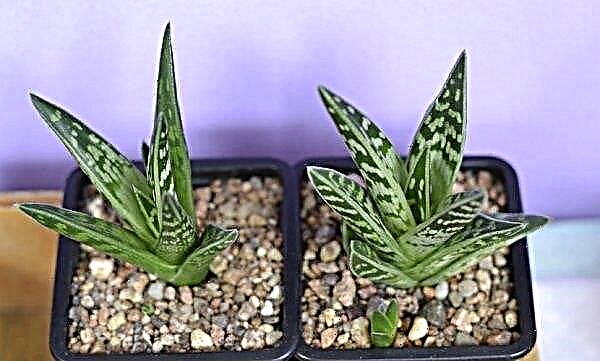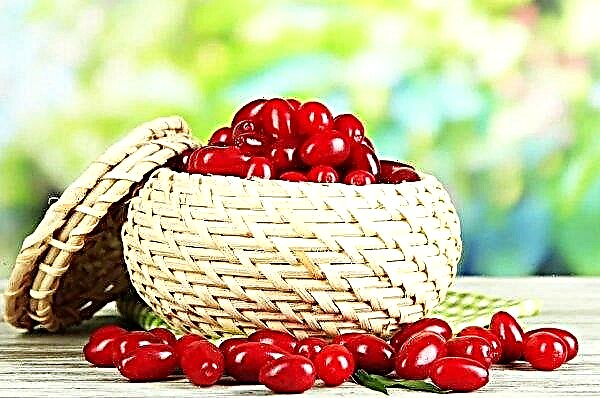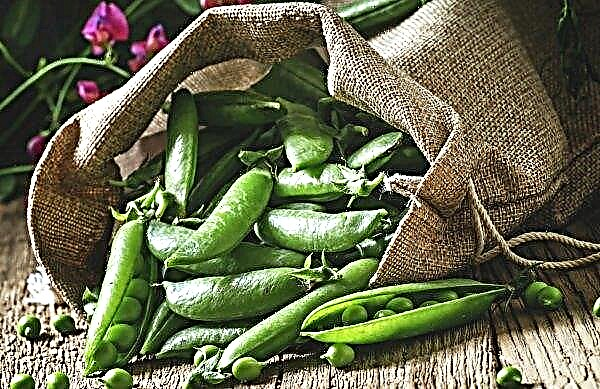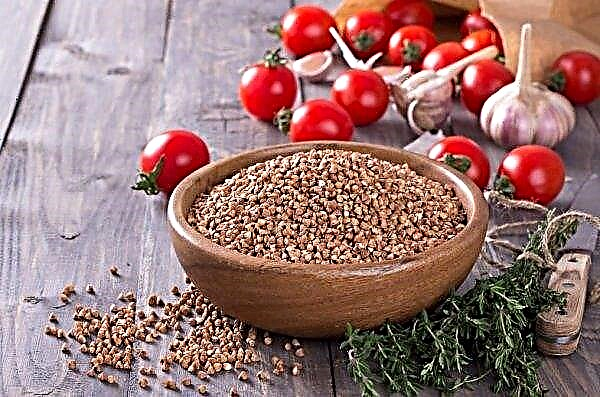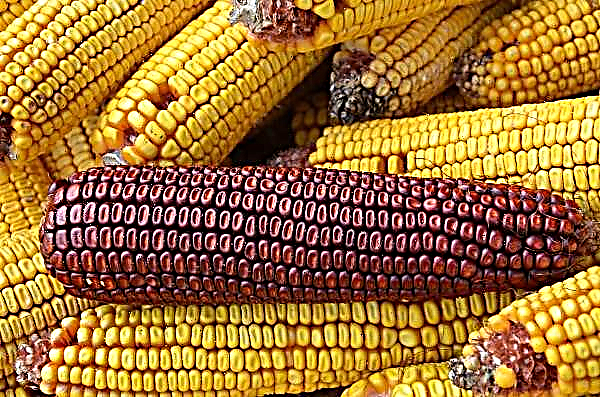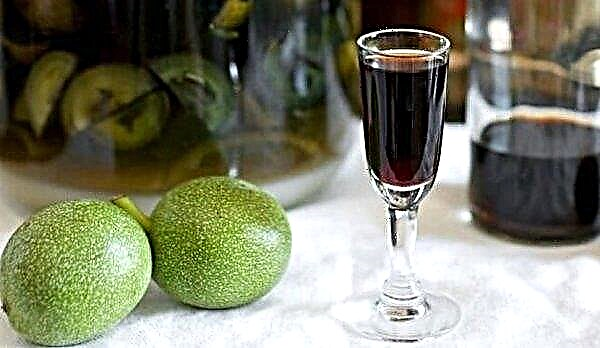More and more often, strange chicken species appear on farmlands. The object of this article was one of them, namely, the representative of Chinese silk, whose amazing appearance managed to conquer not only Asia, but also Europe and America.
From this article you will learn about the origin of birds, their appearance and temperament, as well as the advantages and disadvantages of the breed. In addition, information is provided on what rules should be observed when keeping birds; what to do to young growth healthy than to feed chickens. You will also learn about the diseases that can be encountered when breeding birds, about the preventive measures that are usually taken to maintain the health of birds.
Origin of breed
The exact date of the breeding of Chinese "silk" (as well as the name of the breeder) to this day remains a mystery to researchers. It is only known that the representatives of the breed that live in China - their historical homeland - more than a thousand years.
The first notes about the bird date from the 13th century, when the famous traveler Marco Polo went on a trip to China and Mongolia. In his notes, he most accurately described the appearance and habits of Chinese silk hens. At the time Marco Polo arrived in China, the breed was already distributed in the East and was bred for both decorative and medicinal purposes.
Did you know? One of the most unusual versions of the origin of Chinese silk chickens is the assumption of a group of researchers that the reason for the appearance of such an unusual breed could be the crossing of a chicken with a rabbit. Such a myth appeared due to the unusual, fluffy appearance of a bird.
“Silks” appeared on the territory of Russia only in the 18th century, having crossed the road through Astrakhan and Siberia. They contributed to the spread of the breed in Russia due to the Persian state. After another century, the Chinese silk entered the list of officially approved breeds, compiled by America. From this moment began the spread of fluffy breed around the world.
Breed characteristics
The main feature of Chinese silk chickens is an exotic appearance, because of which it is impossible to confuse "silk" with any other breed. However, this is not their only feature, but only noticeable externally.
Another distinguishing characteristic of birds is the color of their skin, bones and even meat. The feathered organism has a large amount of natural dark pigment called eumelanin. Its presence led to the black color of the skeleton of the bird, brown-black or blue-black skin and gray-black color of meat. For this reason, silk chickens in China are also called "chickens with crow bones." As expected, the appearance of the chicken and the rooster has differences. First of all, the difference lies in weight - the cock is always heavier. In addition, the fluffy chicken looks more miniature: the size of its head and body is slightly smaller than that of a rooster. Its crest is small, there are also catkins. The neck is shorter, the metatarsals and lower legs are also shorter.
As expected, the appearance of the chicken and the rooster has differences. First of all, the difference lies in weight - the cock is always heavier. In addition, the fluffy chicken looks more miniature: the size of its head and body is slightly smaller than that of a rooster. Its crest is small, there are also catkins. The neck is shorter, the metatarsals and lower legs are also shorter.
There is also a difference in plumage - the Chinese chicken is more fluffy in the shins and lower back (while the cock boasts a magnificent tail, mane and fly feathers). Another difference is the color of the feathers. The females have a monochromatic color in soothing colors, but the “men” of down breed against the background of chickens look more colorful and bright.
There are such types of color of feathers: black, silver, lavender, blue, red, yellow, wild. Aboriginal birds have white feathers (a slightly yellowish tint is possible).
Did you know? «Silk» have a branching of productivity: one "line" is decorative and widespread in the countries of Europe and America. In Asia, the second "line" is flourishing - productive. These birds are called «natives».
It is important to know that there are some requirements for color. For example, in chickens with red feathers, the color should be monophonic, the yellow color of the feather is inherent in the bearded variety of the breed, and with black there should not be any inclusions of another color (like red or brown). “Silks” - girls with a blue feather should also have a uniform color, and the color of the plumage of a rooster can be slightly darkened in the lumbar region and mane.
Otherwise, the color of the bird will talk about the uncleanness of fluffy chickens. Future owners of birds of this breed should know that the main sign of cleanliness of the breed is the silkiness of the feathers, and not the color. Birds with different colors of the edge belong to different subspecies of Chinese silk. Read more about other features of the appearance of Chinese "silk" - below.
Description of appearance
The main and most recognizable characteristic of this breed are feathers, more like wool. Other characteristics of the appearance of the "silk" are reflected in the table:
| Appearance | Features |
| Head | Small round |
| Crest | Short, pinkish, blue-red hue, warty |
| Beak | Strong, blue color |
| Neck | Well developed, strong, short |
| Chest | Rounded, deep and full, smoothly into the stomach |
| Stomach | Well developed, full |
| Wings | Quite wide, loose, short, do not fit snugly to the body. |
| Tail | Short, high set, full. |
| Paws | Five fingers of a bluish tint, with short, metatarsally pubescently pubescent on the back side and the same short and fluffy legs |
| Plumage and color | Feathers have an underdeveloped feather shaft, which makes them feel like soft, silky hair. Color can be white, red, blue, lavender, yellow, wild, black and silver. |
Traits
Chinese silk hens have a calm character, their inherent friendliness and sociability. Birds enjoy contact with people, willingly go into their arms and love affection, like cats or dogs. Between themselves, birds, as a rule, are not satisfied with conflicts.
Did you know? The meat products of chickens of this breed have not only excellent taste characteristics, but also medicinal properties. In China, meat is used in the manufacture of stimulants, dietary supplements and medicines that fight headaches, tuberculosis and other serious diseases. The reason for this was the unique substances contained in the meat.
Roosters of this breed can sometimes show aggression if it is necessary to protect their family or compete for attention or primacy among the fluffy "ladies". For this reason, it is recommended that roosters be kept separate from chickens, which are mild and somewhat awkward. They are excellent “moms”, carefully hatching eggs and raising hatched chicks.
The maternal instinct in Chinese silk is so strongly developed that the owners sometimes lay eggs of other birds on the hens so that the chicken will take out the chicks. The chicken copes with this task easily, without showing aggression or rejection to the eggs of others. Despite the fact that the birds get along with each other, the silk ones prefer to stay at a distance from each other and live an independent life independently of each other. An exception may be the situation when they are insecure.
Despite the fact that the birds get along with each other, the silk ones prefer to stay at a distance from each other and live an independent life independently of each other. An exception may be the situation when they are insecure.
Then they will gather in one crowd in order to feel the protection and support of the “relatives”. In a calm time, fluffy chickens move freely around the house and do not come into contact with each other once again.
This breed is often found in contact zoos - places where you can chat with animals, stroke them or feed them. With all the decorativeness and external tenderness, birds have a fairly high resistance to cold temperatures.
Did you know? The character of silk chickens is so docile and soft that the people of China often breed this bird as a pet.
Pros and cons of the breed
Any breed has its pros and cons. Before you start a bird, it is recommended that you carefully read the information about the breed. To understand whether such a feathered pet is right for you, you need to know the advantages and disadvantages of Chinese silk chickens.
- The advantages of the breed include:
- aesthetic appearance;
- resistance to cold climatic conditions;
- unpretentiousness to the conditions of detention;
- beneficial properties of egg products;
- calm, friendly nature of birds;
- the possibility of using silk fluff in rural industry;
- saturation of meat products with amino acids and vitamins;
- highly developed maternal instinct.
- The disadvantages are much smaller, but they are:
- low level of productivity;
- high cost of chicks.
Content of Chinese Silk Chickens
Chinese "silk" is not a whimsical breed, they adapt perfectly to various climatic conditions. The birds of this breed have their own characteristics, which are important to consider when arranging dwellings for them, so that they actively develop, avoid diseases and feel as comfortable as possible. Further, about which diet is best suited for “silk”, and how the hens of this breed cope with the role of fluffy “parents”.
Further, about which diet is best suited for “silk”, and how the hens of this breed cope with the role of fluffy “parents”.
Growing conditions
The first thing that they recommend paying attention to is the room in which the birds will live. The arrangement of the house has its own nuances, observing which, you can grow healthy, beautiful and productive individuals.
Did you know? Chinese «silk» it is necessary to periodically spend a day of haircuts - feathers grow quite quickly in birds and subsequently close their review to them. For this reason, adults need to cut down, which in the future can be used as material for the manufacture of downy things. For one haircut from a bird, you can get up to 100 grams of fluff.
Chicken coop requirements
One of the most important requirements is the humidity level in the house. It should not be too high, and the room itself should be dry and, if possible, warm. "Silks" differ from any other breed of birds in the special structure of the pen.
If ordinary chickens may not be afraid of rain - drops will roll down feathers and not penetrate the skin, then Chinese fluffy ones will quickly get wet and become less attractive in appearance. It is recommended that the house level of humidity not exceed 65%. It is also advisable to protect the walking patio, if any, from excessive moisture.
Despite the fact that “silks” get along well with other breeds, it is best to keep Chinese silk separately from other breeds (in particular, separately from waterfowl, since their presence increases the humidity level in the room; because of this, the litter gets wet faster and becomes dirty ) Another important point is the lack of drafts. Birds tolerate cold well, but drafts can cause diseases, so you need to make sure that there are no cracks, holes or other damage in the walls of the house.
Another important point is the lack of drafts. Birds tolerate cold well, but drafts can cause diseases, so you need to make sure that there are no cracks, holes or other damage in the walls of the house.
From time to time it is necessary to carry out cleaning of the room in which the "silk" live. At the time of harvesting the birds can be sent for a walk or to another room - depending on whether it is summer outdoors or winter.
Important! Make sure that large rodents do not have access to the chicken coop: a large rat or a ferret can bite a bird.
Chinese chickens do not know how to fly. For this reason, there is no need to make them perch at a high altitude - you need to equip it low, or put a small staircase next to which birds could climb it. The same rule applies to the placement of nests. But to provide birds with a deep litter of hay or sawdust is highly recommended.
There is also an option for keeping this breed in cells. It is possible to equip a feathery floor with a fine mesh, but it is important to understand that such a flooring is good only at a warm temperature in the house.
If you don’t have the opportunity to heat the chicken coop in the cold season, and the air temperature drops below 12 ° C during this period, it is recommended to equip the birds with a deep litter - it will keep warm and help the “silk” survive the frosts.
The temperature in the house should depend on how old the bird is:
In the plumage of birds parasites can start. In order to get rid of them, you do not need to disinfect the birds every time. It is enough to install a tank filled with ash and sand in the house.
It is highly desirable that the chicken coop has a large number of windows through which light penetrates inside. In this case, it is not necessary to equip the courtyard for walking, the birds will receive vitamin D without leaving their home.
In winter, daylight hours must be prolonged using artificial light sources so that they continue to lay eggs. True, if the coop is too bright, biting can begin.
Important! It is not necessary to supply a room with a heater, but in this case «silk» cease to lay eggs for a period of cold weather. Under warmer conditions, they will extend egg production.
Walking patio
Silk chickens do not have an active lifestyle, so equipping a patio for walking is another optional condition. But if you have the opportunity to equip a platform for birds in the fresh air, then you need to do this: fresh air and fresh grass in the diet have a positive effect on the development of individuals.
First of all, it is necessary to ensure that the site is dry. This means that marshland and any other with high humidity will not work - the fluff will quickly get dirty and stick together, because of which the birds will lose their attractive appearance. Equally important is the rain protection for the birds. To do this, it is necessary to equip an impromptu roof above the place of walking of the "silk". If this is not possible, it is advisable to cover the courtyard with a fine mesh so that the birds have protection from predators and other, non-domestic birds.
Equally important is the rain protection for the birds. To do this, it is necessary to equip an impromptu roof above the place of walking of the "silk". If this is not possible, it is advisable to cover the courtyard with a fine mesh so that the birds have protection from predators and other, non-domestic birds.
Another important point is the fencing of the courtyard with a mesh netting from all sides. Silk chickens should be well protected from possible attacks by animals or rodents.
Important! It is possible to take out birds with fresh air both in summer and in winter. It is only important to remember that high humidity harms the health of birds, and choose dry days for walks.
If you have a patio for walking, you can even go for a walk even small "silk". Such procedures strengthen the immunity of babies, tempers their body. However, do not abuse the frost resistance of birds and leave them in the cold outside for a long time.
Drinking bowls and feeders
The purity of the house largely depends on the choice of drinkers and feeders. In order not to add extra work and slow down the pollution of the room where Chinese silk chickens live, it is recommended to pay attention to feeders that can be easily transported. As for drinking bowls, the best choice is nipple water tanks. It is imperative to monitor the cleanliness of the container with water - it is a favorable environment for the development of harmful bacteria, so the liquid should be periodically changed to clean.
As for drinking bowls, the best choice is nipple water tanks. It is imperative to monitor the cleanliness of the container with water - it is a favorable environment for the development of harmful bacteria, so the liquid should be periodically changed to clean.
What to feed
Chinese "silk" - unpretentious birds when it comes to nutrition. The same foods can be included in their diet as when feeding other breeds. And yet there are basic rules for making a diet for this breed.
More than 50% of the feed should be cereals.A mixture of rye, wheat and barley is best. It is advisable to add different types of flour to food - bone, fish and shell.
Important! Feather health supplements should be given to birds no more than 2–3 times a week. Their excess in the diet is fraught with consequences in the form of obesity, decreased productivity and negative impact on the work of internal organs.
A properly composed menu will positively affect the state of the feathers. For example, it is good to add nutritional supplements in the form of sunflower and nettle seeds, and oatmeal will also help keep the plumage attractive.
In the summer, the bird can enjoy fresh grass if it is let out on a walking yard; there she will find small worms or insects. In winter, you need to pay more attention to the diet of birds.
Their menu must be varied with vitamin supplements and dried grass - nettle, hay, alfalfa. You can also add vegetable crops, which are preferably heated before feeding.
Instinct of incubation
Chinese silk hens are rightly considered the best “mothers” among all breeds of chickens. The bird is gentle and caring, it takes responsibility for hatching chicks. The fact that the chicken is able to hatch the eggs of other birds (for example, pheasants) has already been discussed above.
Due to its patience and calm nature, the bird will be able to provide the eggs with reliable protection and stable climatic conditions, which favorably affects the development of the embryo inside the egg.
How to grow young
Chickens of Chinese downy chickens are slightly different from chickens of other breeds, so they need to provide favorable conditions for development. Care for the chicks consists in the competent planning of the menu, diet, as well as timely, thorough care and vaccination so that the birds do not get sick. To avoid errors, the information below may be useful.
Proper feeding
Particular attention is paid to the diet of chicks, and for good reason: food for them is the best way to get useful trace elements and substances with which their body will grow stronger, and “silks” will begin to actively develop.
The first thing you need to pay attention to is the diet. Young Chinese chickens should be fed every two hours until they are one month old. Grown chickens are fed every three hours. As the birds grow older, the intervals between meals should be gradually increased so that the grown individual eats three times a day.
As for the diet itself, feathered babies need to be fed with cereals, vegetables, dairy products. Good effect on the development of chicks and the addition of special feed for chickens. From grain crops millet, corn and semolina are perfect; any vegetables are suitable, but they must be thermally processed.Important! All food that chicks consume must be of high quality.

From dairy products, it is recommended to add cottage cheese, kefir and sour cream to the menu. All foods should be low in fat. Mandatory boiled yolk and chopped eggshell. Do not disdain kids and meat broth.
As a dietary supplement, fish oil, which needs only a couple of drops, is suitable. It is worth paying attention to the addition of vitamins A, B, and E to chicks. If you prefer to buy ready-made feed mixtures, look at the protein content in the product: silk chicks need to get about 20% protein.
For little Chinese chicks, you also need to install a drinking bowl and make sure that there is always clean water there. Vacuum drinkers can be used for this purpose. To saturate the body of chicks with useful substances, it is recommended to add vitamin complexes to food, the content of which in the bird menu should be about 40%.
Did you know? When the silk chicks grow up a bit, they can be kept in the same room with «mommy» - the chicken will make sure that the kids eat on time, and if necessary warm the offspring.
There are contraindications to the menu of down chickens. They should never be given raw meat, unprocessed vegetables; coarse food is also banned - “silks” can suffocate. Taboo products are chocolate in any form and poisonous plants.
All this may contain substances poisonous to small birds or be infected with various diseases. Feeding them with birds is fraught with consequences not only for their health, but also for yours, because all products received from diseased "silk" will also be infected.
Care
Silk babies are about half the size of ordinary chickens. For this reason, these chicks are more sensitive to climatic conditions, and they need to ensure a comfortable air temperature. Having paid due attention to the microclimate in the room where the chicks are located, you will take care of the timely plumage of the babies and their health.
Wherever the chicks are located, the room should always be clean. As with growing any other chickens, you need to monitor hygiene standards and clean in time. The air temperature in the room should be 30 ° C. In such conditions, newborn “silk” will feel as comfortable as possible. Over time, the temperature can be lowered by 2-3 ° C per week. However, avoid sudden changes and monitor the behavior of the chicks.
The air temperature in the room should be 30 ° C. In such conditions, newborn “silk” will feel as comfortable as possible. Over time, the temperature can be lowered by 2-3 ° C per week. However, avoid sudden changes and monitor the behavior of the chicks.
If necessary, place them in a brood hen, which if necessary warms the chickens. The temperature should be lowered so that the chicks of one month of age feel well at an air temperature of 18 ° C.
Vaccination
Newborn chicks do not yet have strong immunity, unlike adults, so their health should be taken care of. Young “silks” will receive many useful trace elements from food, however, to prevent the development of a number of diseases to which birds of this breed are susceptible, vaccination should be carried out. It is advisable to carry out this procedure to chickens at an early age.
Diseases of Chinese silk chickens and their prevention
Like any other chickens, Chinese "silk" can get sick. To prevent the occurrence of diseases, it is necessary to carefully care for the birds, provide them with proper living conditions, and also know what preventive measures are. By taking them in time, you will help your feathered pets maintain their health.
Find out more

Most often, birds with silk plumage are sick:
- rickets;
- coccidiosis;
- lung diseases;
- respiratory viral infections;
- inflammation of the gastrointestinal tract;
- intoxication of the body;
- infectious bowel diseases;
- the appearance of worms and pests in feathers (fleas, ticks, and down-eaters).
To avoid such diseases, it is necessary to take preventive measures in time. Wet cleaning of the chicken house, which should be carried out regularly, will help to take care of the welfare of silk. The walls, floor, and containers for water and food must be washed; it is necessary to periodically renew the litter.
It is equally important to ensure that, along with the food, the birds receive a sufficient amount of vitamins and nutrients, with which the feathered immune system will become stronger.
Another preventive measure is the presence of fresh water in the drinkers. Water tanks are a favorable place for the development of harmful microbes and fungus, so it is important to change the water in a timely manner and monitor its purity. The food that downy chickens eat should always be fresh. Spoiled products should be thrown away, otherwise the bird may get intoxicated.
Chinese representatives are resistant to cold, but severe frosts can contribute to the weakening of their body. To prevent this from happening, in the cold winter you should take care of the warming of the house. In the warm season, it is advisable to provide chickens with a chance to walk. This is not a prerequisite, but fresh air, coupled with fresh grass, has a beneficial effect on the avian organism.Did you know? Silk birds are able to adapt to different climatic conditions, but the presence of draft in the room can lead to a disease. Severe frosts also weaken the immunity of birds.

If the bird is already sick, it is necessary to isolate it from other chickens as soon as possible in order to avoid the spread of infection. The next step will be to call a veterinarian and examine the remaining birds. Following all these recommendations, you are unlikely to encounter diseases of silk chickens - this breed has a fairly strong immunity.
So, Chinese silk hens are not only a decoration of the yard. The breed has good productivity, are characterized by a pleasant and light character. They are unpretentious to living conditions and food, which greatly simplifies their maintenance. In order for the "silk" to please you with its appearance and productivity, you need to be responsible for their health and remember the features of the content of this breed.


